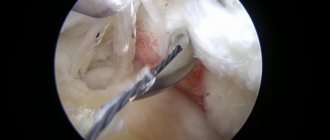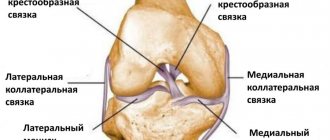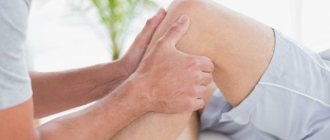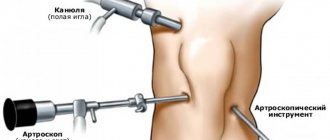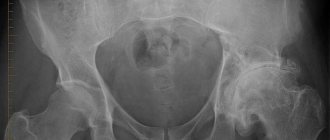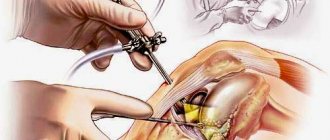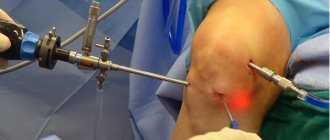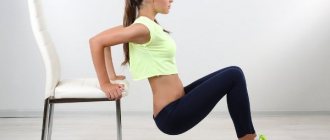Restoration of the knee joint after arthroscopy is a mandatory measure necessary for the full return of functionality of the operated lower limb. Without intensive rehabilitation treatment after any type of arthroscopic intervention, be it associated with anterior cruciate ligament repair, removal or suturing of the meniscus, it will be difficult to return to normal physical activity in a short time. Moreover, lack of proper foot care greatly increases the risk of complications. Therefore, going through all stages of knee joint restoration is extremely important to guarantee a successful outcome.
When the stitches have not yet been removed.
Very often, patients are surprised after arthroscopy when they are told about knee joint restoration. They believe that if they were discharged on the day of surgery or on days 2-3, then there is nothing serious - everything will return to normal on its own. But it is necessary to understand that it does not matter at all when the discharge was issued - in a day or a week - in any case, this is a surgical intervention, the result of which entirely depends on compliance with a unique rehabilitation regime. If knee arthroscopy has been performed, rehabilitation after surgery should be arranged without question. The doctor must inform you about what procedures and exercises to do.
It is preferable to take all post-operative measures in a treatment and rehabilitation center, where patients who have undergone such surgery are cared for. All conditions have been created there for high-quality rehabilitation after arthroscopy - surgery on the knee joint. Specialized medical institutions are equipped with effective simulators, specially designed for passive-active development of individual joints of the lower extremities, and unique physiotherapeutic systems. But most importantly, all your activities, general well-being and the condition of the operated leg will be monitored by competent rehabilitators.
Postoperative period
This stage begins from the very first minutes after surgery, when arthroscopy is completed: early rehabilitation of the knee joint lasts approximately 48 hours. The person is in a hospital where he receives the necessary medical care, including:
- administration of painkillers, anti-inflammatory, vascular drugs, broad-spectrum antibiotics and dietary supplements based on glucosamine and chondroitin;
- treating the wound, applying a sterile dressing to prevent infection;
- bandaging with an elastic fixing bandage to immobilize the joint as much as possible and also prevent the development of edema;
- supra-articular cryotherapy, that is, applying dry ice compresses to the cup to prevent swelling of the soft tissues and reduce pain.
The operated limb is wrapped in an elastic bandage.
During this time, loads on the joint are eliminated. The knee is fixed in a straightened state, the leg is in an elevated position. For now, the patient will be required, in addition to undergoing the above procedures, to perform an exercise to contract the quadriceps femoris muscle and an isometric warm-up of the ankle. The initial rehabilitation phase can be longer or shorter, it all depends on the type and volume of surgical intervention.
Remember, it doesn’t come instantly and right away how the arthroscopy of the knee joint went, recovery after surgery, people’s reviews will help you verify this. Whatever one may say, this is an internal invasion of a complex part of the musculoskeletal system and the implementation (attention!) of surgical manipulations in its structures.
After approximately 48-72 hours, the wound heals, and, as a rule, the patient is discharged from the inpatient department, but the postoperative treatment does not end there. The doctor must inform where and how to continue further measures aimed at final recovery after knee arthroscopy.
Structure of the knee joint
The knee joint is formed from the base of the femur and the top of the tibia. The patella is located on the front surface of the knee joint. Around the joint are muscles, ligaments and tendons. A huge role is played by the joint capsule, in which the natural production of fluid occurs for normal gliding of the joint. Most often, diseases and damage to joints occur in athletes or people leading a sedentary lifestyle. As a rule, any pathology is accompanied by pain and impaired motor activity; a person cannot independently extend the lower limb and move normally.
Rules for out-of-hospital rehabilitation: early period
In reviews of arthroscopy - surgery to restore the knee joint after injury - you can read that some patients were allowed to leave the hospital’s inpatient unit the next day. Indeed, this happens. However, there is no need to universalize all medical cases, because each of us understands that the length of hospitalization, as well as recovery, directly depends on the severity and etiology of the diagnosis and the scale of the surgical intervention. Therefore, some may need to stay in the hospital for 1-3 days, and for others 10 days. Let us once again emphasize that, regardless of the time of hospitalization, rehabilitation is mandatory for the knee joint!
Walking up stairs is one of the rehabilitation activities.
Patient Reminder
So, arthroscopy of the knee joint is over, early recovery after the operation was “excellent”, the attending physician’s feedback on the treatment was positive. If the clinical picture is satisfactory, you will be released from the hospital with outpatient treatment. Upon returning home, in order to avoid complications, you will need to strictly adhere to all instructions and recommendations given by the orthopedic surgeon.
- During the first week, it is necessary, as already noted, for the leg to be positioned as elevated as possible in order to reduce swelling.
- Do not get the surgical suture wet; make sure it remains dry and clean. The question of taking water procedures should be agreed with a specialist.
- The patient needs to see a doctor every two days for 7-12 days for aseptic treatment and dressings. It is possible that if an accumulation of effusion is detected in the joint, during control visits it will be evacuated using a puncture. The stitches are removed no earlier than after a week.
- Vascular, analgesic medications and chondroprotectors should continue to be taken according to the regimen developed by the surgeon. Cold dry compresses are used for approximately 5 days after surgery.
- If a meniscectomy of the knee joint has been performed, in simple terms, resection of the meniscus, rehabilitation already on the second day after arthroscopy includes careful walking with a limited load on the sore leg. You should walk for 5-7 days (in doses!) exclusively with support, using auxiliary orthopedic devices that serve as additional support.
- When recovering from knee arthroscopy, when the meniscus was not removed but sutured, you will need to walk with crutches longer. Crutches are used for about a month, and when moving you cannot transfer your body weight to the problem limb. For ACL reconstruction, assisted walking is prescribed for at least 3 weeks.
- When performing the prescribed exercise therapy after arthroscopy, a moderately stiff knee brace or an elastic bandage is put on the knee joint. The patient may be prescribed to wear an orthopedic device (orthosis), which is fixed at the permitted angle of flexion, for example, if correction of ligamentous structures has been made. During the night's rest, the orthotic device is placed in the extension position.
The basis of the range of rehabilitation measures at each stage is a set of exercise therapy exercises after arthroscopy of the knee joint; the video more clearly displays their methodology. However, video materials should not serve as a reason for not visiting a qualified medical institution.
In the event that torn ligaments or meniscal fragments were compared, the development of the knee will have to be delayed for a certain time until the connected tissues have firmly fused.
How is arthroscopy performed?
The procedure is performed under anesthesia. Several options are practiced depending on the age and condition of the patient: local anesthesia (pain relief covers only the knee), regional (to the waist) and general (medicated sleep). In the first two cases, the patient can watch the procedure on a monitor, but not everyone is ready for such an experience.
The surgeon makes several small incisions on the knee. Sterile salt water or saline solution is pumped into them to expand. An arthroscope with a built-in camera is inserted into the joint. The image from it is transmitted to the monitor in the operating room. The specialist examines the joint, twists and folds, detects a problem, then, if the clinical picture allows, inserts small instruments into the incisions and corrects the problem (for example, excises damaged areas of the meniscus).
At the end of the operation, saline solution is removed from the joint, and the incisions are sutured. The wounds are treated with antiseptics and a sterile bandage is applied. The procedure takes from 30 to 60 minutes.
This is what an arthroscope looks like
Physiotherapy
In order to accelerate the repair processes, effective physiotherapeutic treatment tactics are used, performed on an outpatient basis, such as:
- electromyostimulation;
- laser therapy;
- magnetic therapy;
- electrophoresis;
- UHF treatment;
- light lymphatic drainage massage.
Electrical stimulation
Physiotherapy can also include other procedures, and each of them is selected on a purely individual basis. It is important to note that physical techniques are used throughout all stages of knee rehabilitation after arthroscopy. They comprehensively stimulate self-regeneration mechanisms, improve metabolism, improve tissue trophism, prevent postoperative consequences, activate blood circulation and lymph outflow, and reduce pain and inflammatory reactions.
Indications and contraindications
Let us immediately note that treatment extremely rarely leads to negative consequences. However, this cannot be ruled out if it was done despite contraindications. But first we will cover the recommendations, and then the restrictions.
Partial tear of the lateral ligament of the knee joint.
The procedure may be prescribed for:
- an unclear cause of pathological symptoms, when other methods are powerless to establish it;
- ligament ruptures, damaged tendons;
- suspected dislocation of the calyx (patella);
- the presence of free bodies in the cavity;
- inflammation of the synovial membrane of unknown origin;
- aseptic necrosis of the head of the articular bone;
- injuries, degenerative-dystrophic diseases of the meniscus;
- arthritic disease and gonarthrosis;
- intra-articular fractures, etc.
It is contraindicated in the presence of such ailments as:
- hypertension;
- diabetes mellitus in the stage of decompensation;
- disturbed balance of blood clotting;
- severe dysfunction of the pulmonary or cardiac systems;
- local skin inflammation.
Therapeutic and diagnostic arthroscopy is performed with caution; the consequences can be unpredictable if you are allergic to local/general anesthetic. Therefore, be sure to tell your specialist if you are prone to allergic reactions to any medications.
Physiotherapy
As for exercise therapy in the initial period, after arthroscopy of the knee joint it solves the problems of stabilization, elimination of inflammation, normalization of blood flow, prevention of contractures, and consistent restoration of motor and support functions. At the same time, axial high-amplitude loads are excluded! The following activities are recommended three times a day:
- static muscle tension in the anatomical plane of the hips and buttocks;
- simultaneous movements of the feet towards/away from oneself, clockwise and backward rotation (do 10 exercises each);
- Exercises for flexion and extension of the knee are gradually introduced in an acceptable range that does not cause pain, and they are mainly done lying down so that the back of the foot is in continuous contact with the surface (number of repetitions - 6-8 times);
- from a lying position, slowly lift the straight limb (45-60 degrees) with the toe facing yourself - hold it suspended for five seconds, then smoothly lower it onto the bed (8-10 sets);
- a similar exercise can be done while standing (when you can start doing it, the rehabilitation specialist decides).
Rehabilitation after arthroscopy of the knee joint, whether resection of the meniscus was performed or restoration of other elements, is always based on exercise therapy and physiotherapy. But remember that only a doctor can prescribe an algorithm for restorative measures taking into account your specific medical problem. You cannot include a single movement without the knowledge and consent of a highly qualified physician. It is also strictly forbidden to independently introduce innovations in rehabilitation after arthroscopy of the knee joints with resection of the meniscus, including after any reconstructive plastic surgery.
Important information! Until the end of the fourth week, rehabilitation after knee arthroscopy at home is not recommended, especially performing exercise therapy via video from the Internet. Lack of close monitoring by professional rehabilitation instructors and an orthopedic doctor, and the slightest errors in exercises are fraught with serious complications, instability and inferior mobility of the bone joint.
Concept and advantages of the procedure
The surgery is performed using specialized, state-of-the-art fiber optics integrated into an innovative device called an arthroscope. Thanks to the unique device, the procedure got its name. The process involves an internal study of bone and cartilage tissue, menisci, tendons, muscles, ligaments, connective tissue elements, and synovial fluid.
Image of the joint cavity.
For the purpose of highly informative diagnostics, a specialist, through a microportal, inserts the working tube of the device into the joint, into which a system of ultra-strong lenses, a powerful light source and digital video recording equipment are mounted. All structures that the arthroscope “sees” are visualized on the screen in a “live” form, and the image is received in a many times enlarged format. The doctor can find the exact location of the injury or degenerative changes, determine the nature of the pathology, the severity and take action.
Arthroscopy has been proven to be superior to any existing diagnostic methods. It clearly shows from the inside all the structural units of the bone connection in the smallest detail, allowing you to identify even small hidden damage that cannot be detected using standard fluoroscopy or arthrography, ultrasound, MRI, CT and other popular imaging methods.
The method is used not only as a diagnostic tool, but also as a therapeutic and restorative tactic. Having discovered certain violations of the cartilage surface, the doctor can immediately eliminate them. He will perform surgical manipulations through an additional incision (about 6 mm in size) using microsurgical instruments, and he will perform the entire process while looking at the monitor.
Middle phase: after 3 weeks
Even if you think that everything has healed, you should not abandon recovery after arthroscopy of the knee joints at the beginning of this stage; reviews from orthopedists urge you to be prudent. The time period from the date of surgical intervention to the present moment is still too short for the functionality of the injured segment of the locomotor system to fully return to 100%. On average, the final recovery of a knee, shoulder or ankle after arthroscopy takes 2-4 months, and sometimes it may take 6-12 months.
Competent rehabilitation of the knee joint after arthroscopy allows you to highly productively restore the functions of the joint to the previous pre-traumatic level. The quantity, intensity, and range of movements have now noticeably expanded, pain and swelling are no longer a concern, the extensor potential has been completely restored, and the range of flexion corresponds to 90 degrees or more.
If the dynamics are positive, you are allowed to move without crutches, but do not forget to still use a product that supports the joint. In this case, you can already fully stand on your foot. In principle, it is possible to continue rehabilitation after arthroscopy at home. But, without deviating from the standard of physical activity that the doctor determined for you. Nevertheless, in order not to take risks and achieve excellent results, it is advisable to continue to remain under the supervision of a competent health-improving physical education trainer. So, starting from the 22nd day and for about 2 weeks, it is important:
- work on the formation of a normal gait, while you need to make sure when walking that the leg does not limp, the step is small, and the pace of movement is measured (do not overload the knee with long walks!);
- continue to develop the muscle complex of the hip region, stretch the areas of the lower leg and foot;
- use shallow springy squats with a flexion amplitude of 30°-40°, gymnastics with resistance from elastic mechanisms (tourniquet, expander), adduction/abduction of the limb (lying on the healthy side);
- gradually include weight-bearing exercises (prohibited without proper methodological support!)
- train on a special exercise bike in a gentle mode, attend therapeutic aqua gymnastics (swings, walking in water, swimming);
- If necessary, attend manual and physical therapy sessions.
4-6 MONTH:
- Continuation of activities aimed at strengthening muscles and coordination of movements.
- Jogging on a flat surface is possible.
- Using a knee brace during loads, the danger of awkward movements (transport, travel) and exercise therapy.
It is necessary to avoid premature increased loads, early return to sports, sudden leg extensions, especially straight leg movements, jumping, running on hard or uneven surfaces, twisting loads, falls, and uncontrolled movements during sports exercises.
Limiting sports activities after ACL surgery is necessary for up to 4-6 months. Limiting contact or team sports to 9-12 months.
I would also like to emphasize that the selection of a rehabilitation program should be carried out individually and take into account many factors. This is a fairly long and important stage of treatment, without which it is unlikely that good functional treatment results will be achieved.
Final stage of recovery
She comes into her own from 5-6 weeks. Please note that in case of ruptures of the ligamentous-capsular elements, if arthroscopy with the use of knee joint plastic surgery was used, recovery after surgery is a multifaceted, complex and very long work. Therefore, you may have to be patient, since in some situations the interval until the final stage may stretch out somewhat, and, of course, do not forget about vigilance, diligence and responsibility.
Rehabilitation after arthroscopy of the meniscus of the knee joint, the anterior patellar ligament and other articular components in this cycle is already much simpler and painless. The specialist evaluates the dynamics of knee recovery after arthroscopy over time. Provided that the organ being rehabilitated does not cause suspicion of health, the orthopedic traumatologist allows you to diversify the physical activity.
Orthopedic devices (non-rigid fixators) are put on during training. Previously performed daily exercises after knee arthroscopy, videos demonstrate their technique well, complement:
- training on training blocks (without loading the quadriceps);
- squats with a flexion angle of 60°;
- climbing onto a stable step platform, holding the handrail;
- running and walking in the waters of the swimming pool;
- swimming in the sports breaststroke style, which is also important for the restoration of the shoulder joint after arthroscopy;
- slight swinging of the body to the right and left, standing on your feet in the position of bent knees, and other coordination movements designed to improve the coordinated work of the muscles.
Unlimited walking, careful lateral and front lunges, and balancing exercises while standing on one injured limb are allowed only after 2 months. Running, jumping, swinging legs, sudden movements, twisting exercises are dangerous with negative consequences, therefore, until the biomechanics of the bone joint is fully stabilized, avoid these types of activities for as long as possible, up to six months.
Whatever you read about this phase of recovery after knee arthroscopy in reviews, keep in mind that you can return to normal physical activity no earlier than after 4 months. Remember that the fullness and quality of your future life depends only on you.
The outcome and pace of your recovery depends on how wisely you approach the issue of arthroscopy on the knee joint and the problem of recovery after surgery. Do not neglect the consultations and recommendations of experienced specialists; only their competent assistance and your diligence will help you achieve the desired effect - full working capacity and readiness to lead an active lifestyle like a physically healthy person.
Preventive actions
Joint diseases have a genetic predisposition. If one of your relatives has problems with joints, there is a high risk that this problem will affect you too. If you follow several rules of prevention, this can be avoided: Avoid hypothermia. Don't overdo your workouts. Work with heavy weights should only be carried out under the supervision of a specialist. If pain or discomfort occurs, consult a doctor immediately. Remember that any pathology is much easier to treat at an early stage. Try to move more, walk and do exercises daily. If you couldn’t avoid troubles with your joints, don’t despair. Arthroscopy is a unique way to eliminate the pathological process in a minimally invasive way. There are no scars or scars left after the operation, and the recovery period is also relatively fast. Patients soon return to their normal lifestyle and even continue their sports career.

